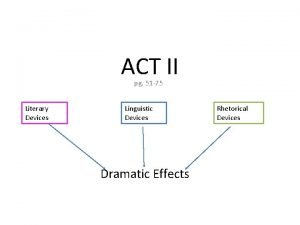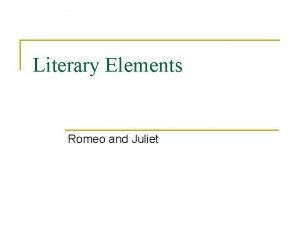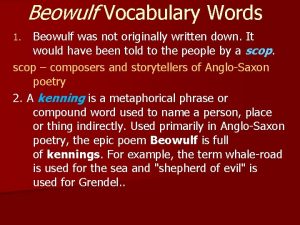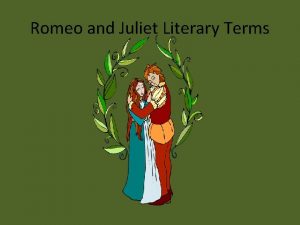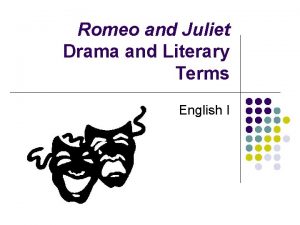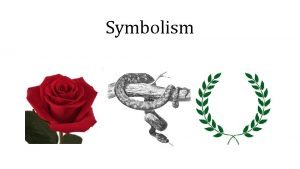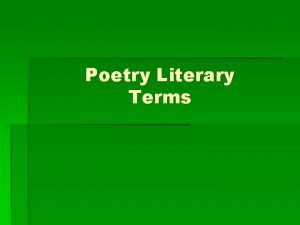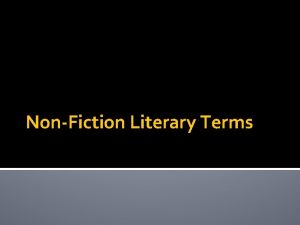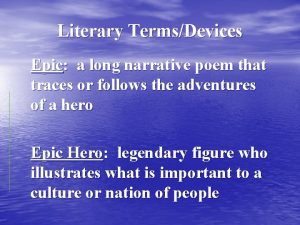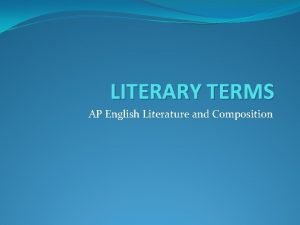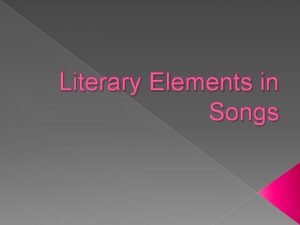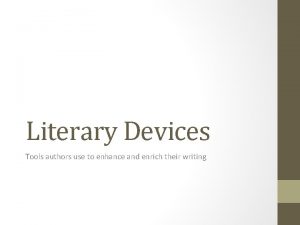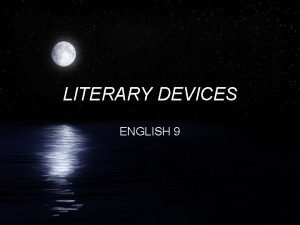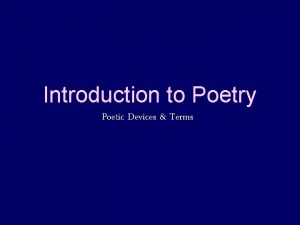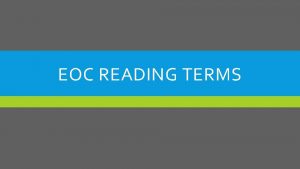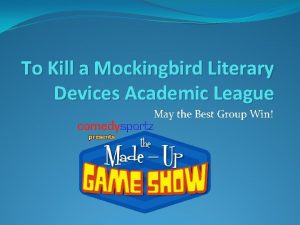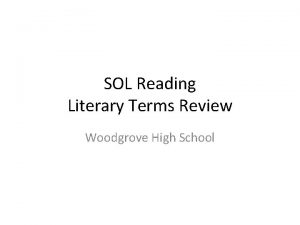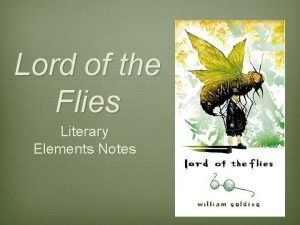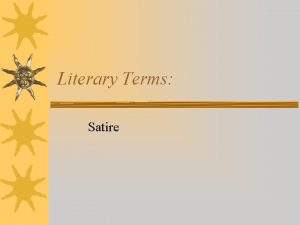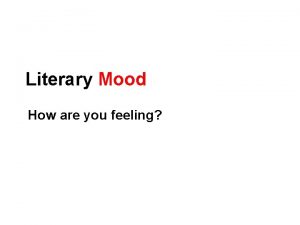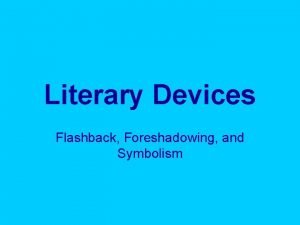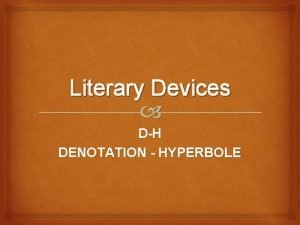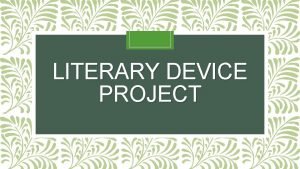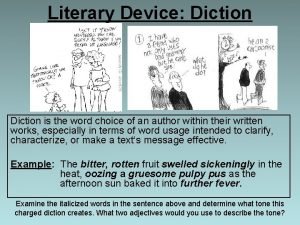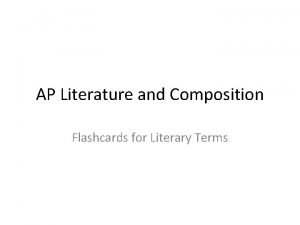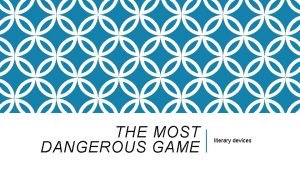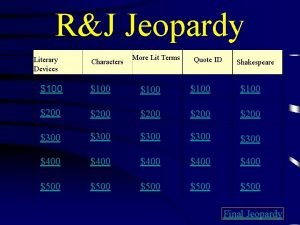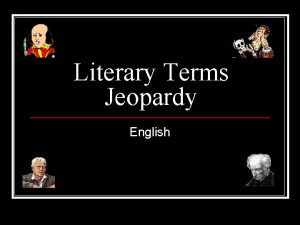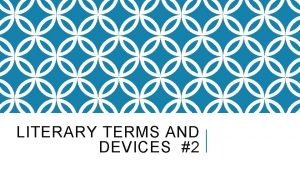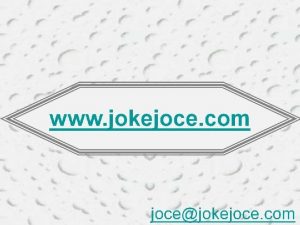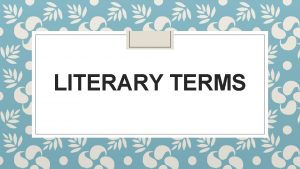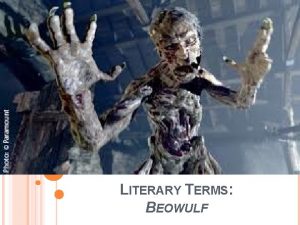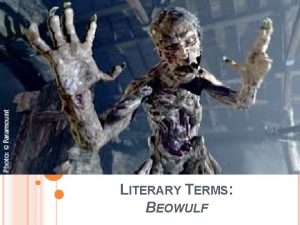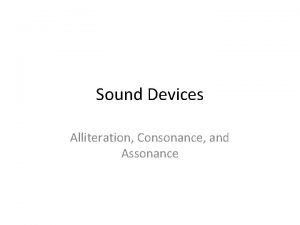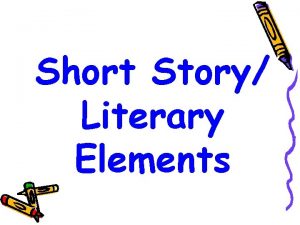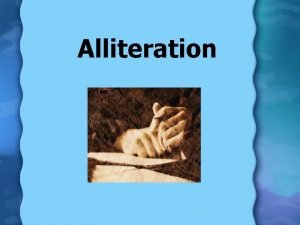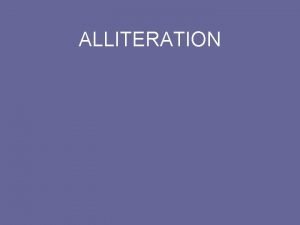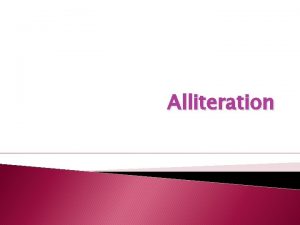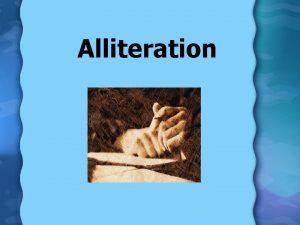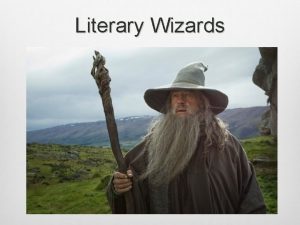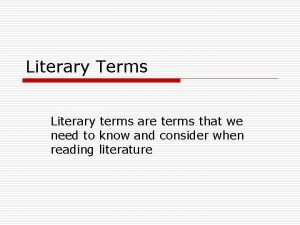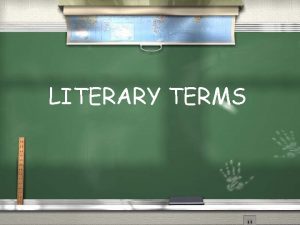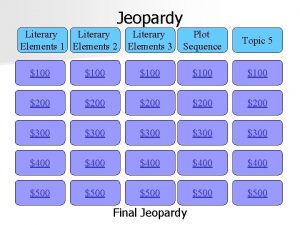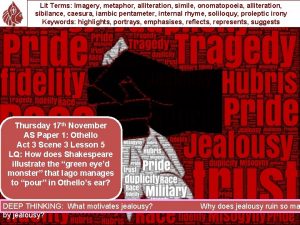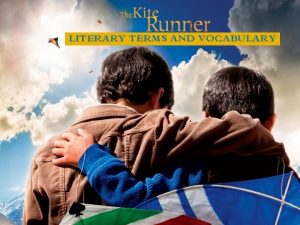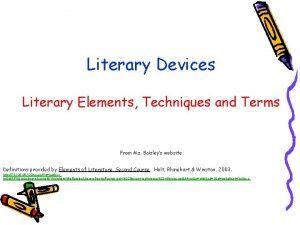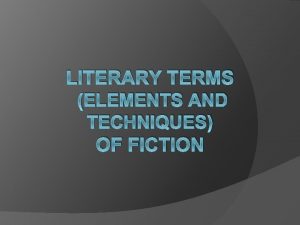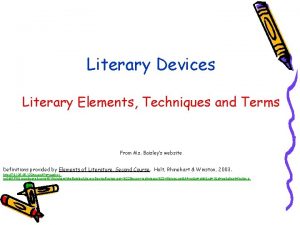LITERARY TERMS AND ELEMENTS Ms Mailloux ALLITERATION The








































- Slides: 40

LITERARY TERMS AND ELEMENTS Ms. Mailloux

ALLITERATION The repetition of initial consonant sounds (first letters) Example: She sells seashells by the seashore.

ALLUSION A well-known reference in a work of literature Example: He was a regular Romeo the way he flirted with the girl.

ANTAGONIST The character or thing that causes conflict in a story. *It can be a person, thing, natural element.

ANACHRONISM Anything that is out of time and out of place is an anachronism. Example: A story about the ancient Greeks has a character saying, “Hola!”

ASIDE In a play, it is when a character speaks to the audience and the rest of the characters cannot hear what is said

CLIMAX The highest point of action or turning point in a story.

CONFLICT The problem in a story Example: a boy lost his dog

DICTION Specific word choice (usually slang or accents) that show something about a character Example: Howdy, y’all! Hullo, govna’! Care for a spot of tea?

EXPOSITION Part of the plot structure that provides background information on setting, characters, and conflicts. Usually at the beginning of the story

FALLING ACTION The part of the plot structure where the problem gets solved.

FIGURATIVE LANGUAGE Language that compares two or more things Examples: She was like a baby. It was a million degrees outside. The waves swallowed the ship.

FLASHBACK A narrative technique where past events are recounted or detailed in current time. Example: I remember it was a beautiful, summer day when we met. The sun sparkled on the ocean…

FOIL A character that has contrasting qualities from another character in the story. The contrast is meant to highlight the other character’s qualities. Example: Elsa and Anna from FROZEN

GENRE A type or category of literature Examples: Nonfiction, science fiction, historical fiction, fantasy

HYPERBOLE A type of figurative language that is an extravagant exaggeration Example: The sidewalk was hotter than the sun. You are the worst human being alive.

IMAGERY Description that appeals to the 5 senses. Example: The fluffy, golden cake’s sugary sweetness melted in my mouth.

IDIOM A commonly used saying. Example: He was like a bull in a china shop.

IRONY 3 types of irony: Dramatic: when the audience knows something that the characters do not Situational: when the opposite of what is expected happens Example: A lifeguard drowning. Verbal: when someone says something but means the opposite (sarcasm) Example: Of course I want more homework! Who wouldn’t?

METAPHOR A type of figurative language that compares two unlike things Example: Our love was a red rose. He was a cheetah running around the track.

MOTIF Something( can be a symbol) that is repeated throughout a work of literature that is connected to a theme Example: In The Hunger Games: food being mentioned and used to control people.

PATHETIC FALLACY When the setting or nature changes to reflect the mood of the story Example: Rain on the day of a funeral

PERSONIFICATION A type of figurative language that gives inanimate objects human characteristics Example: The car growled as it started.

PLOT The sequence of events in a story.

POINT OF VIEW The perspective that a story is narrated from Example: 3 rd person omniscient 1 st person limited

PROTAGONIST The main character or the lead role in a work of literature (often the hero) Example: Katniss from Hunger Games

OXYMORON A contradiction Example: jumbo shrimp

POETIC JUSTICE In literature, poetic justice is an ideal form of justice in which the good characters are rewarded and the bad characters are punished by an ironic twist of their fate. Example: A thief gets his car stolen.

PUN A play on words used to create humor that gives a word double meaning. Example: A horse is a very stable animal

RESOLUTION The part of the plot structure that explains what comes after the problems are solved. Example: …and they lived happily ever after.

RISING ACTION The part of the plot structure that sets up the conflict and builds suspense.

SETTING The time and place that a story takes place in

SIMILE A type of figurative language that compares two unlike things using “like” or “as” Example: She was as pretty as a flower. He sang like a bird.

SOLILOQUOY When a character talks to himself or herself in a play. Example: “To be or not to be…” *Hint: Soliloquoy and self both start with “S”

STANZA A GROUPING OF LINES IN A POEM

STEREOTYPE An assumption made about a group of people—often incorrect or offensive. Example: All girls love makeup and shopping.

SYMBOL/ SYMBOLISM When an object or word in a work of literature represents a bigger idea. Example: American flag=freedom, heart=love, clover=luck

THEME The author’s message in a work of literature Hint: themessage

TONE The attitude of the author coming across in the story

MOOD The feeling or emotion evoked in the reader in a piece of literature
 75 literary terms elements and devices
75 literary terms elements and devices Literary device
Literary device Polynomial classification
Polynomial classification Identify like terms
Identify like terms Literary terms in romeo and juliet
Literary terms in romeo and juliet Alliteration romeo and juliet act 1
Alliteration romeo and juliet act 1 Vocabulary words in beowulf
Vocabulary words in beowulf Example of simile in romeo and juliet
Example of simile in romeo and juliet A long uninterrupted speech by one character
A long uninterrupted speech by one character Literary devices jeopardy
Literary devices jeopardy What does symbolism
What does symbolism Literary definition of symbol
Literary definition of symbol Literary terms hyperbole
Literary terms hyperbole Nonfiction literary terms
Nonfiction literary terms Literary terms epic
Literary terms epic Ap english literature terms
Ap english literature terms Simile examples in songs
Simile examples in songs Symbol rhetorical device
Symbol rhetorical device Metaphor definition literature
Metaphor definition literature What is mood in poem
What is mood in poem Palindrome poem
Palindrome poem What is an elegy in literature
What is an elegy in literature Literary terms of drama
Literary terms of drama To kill a mockingbird literary terms chart
To kill a mockingbird literary terms chart Aside definition literature example
Aside definition literature example Macbeth literary device
Macbeth literary device Setting of lord of the flies
Setting of lord of the flies Literary terms satire
Literary terms satire Literary terms review game
Literary terms review game The feeling created in the story
The feeling created in the story The lottery shirley jackson literary analysis
The lottery shirley jackson literary analysis Foreshadowing in literature
Foreshadowing in literature Exposition of a story example
Exposition of a story example Literary terms project
Literary terms project What is diction literary device
What is diction literary device Ap english literature and composition flashcards
Ap english literature and composition flashcards The most dangerous game personification examples
The most dangerous game personification examples Jeopardy literary terms
Jeopardy literary terms Literary terms jeopardy
Literary terms jeopardy Diction literary definition
Diction literary definition Indirect characterization definition
Indirect characterization definition
